1lumen selects and reviews products personally. We may earn affiliate commissions through our links, which help support our testing.
Rovyvon A33 Aurora review
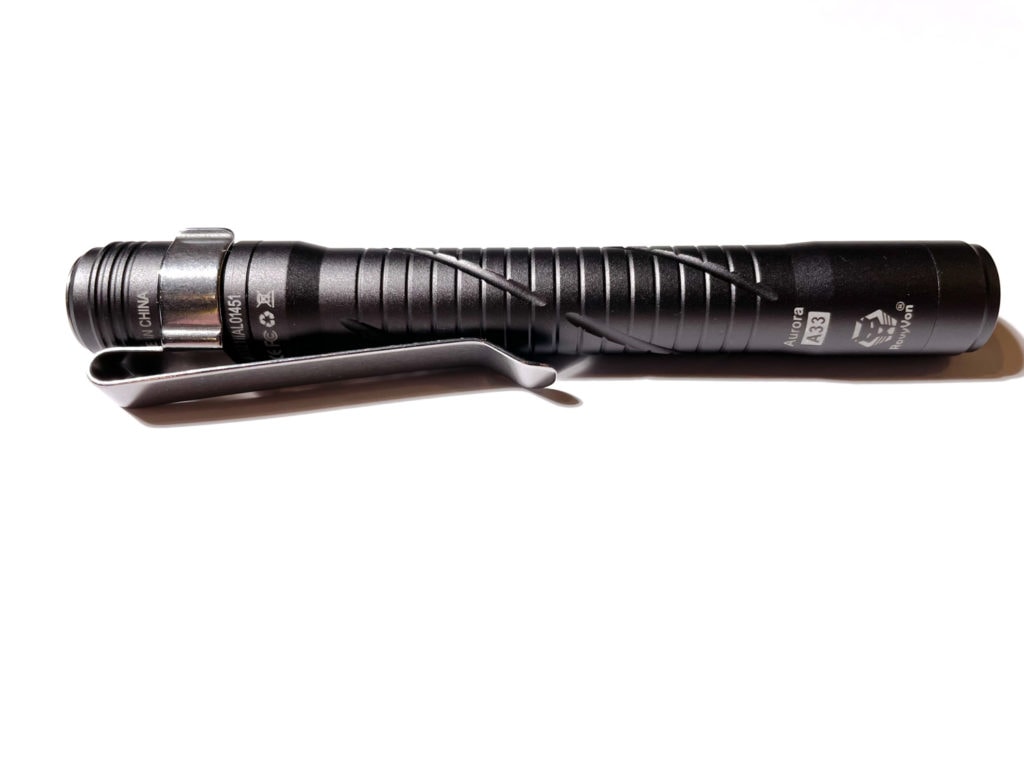
Rovyvon A33 Aurora specifications
| Brand/model | Rovyvon A33 Aurora |
|---|---|
| LED | Nichia 219C |
| Max. Lumens | 180 Lumens (High) |
| Max. Beam intensity / distance | N/A |
| Battery config. | 1*600 mAh Internal Battery (Not user removable) |
| Onboard charging | USB-C |
| Modes | 4 |
| Blinkies | Strobe |
| Reflector | TIR lens |
| Waterproof | IPX8 |
| Review date | May 2022 |
Introduction:
RovyVon is a strange manufacturer, straddling the line between more mainstream lights such as their keychain products, and some truly niche creations. They have been around for more than 10 years, producing a very popular line of keychain lights and some that are headscratchers. Lately they have been working on more “traditional” lights, such as those designed for work and tactical uses. They even have some very fancy, very expensive, limited edition lights such as a timascus version of their classic A-series keychain lights.
Today I’m taking a look at one of their more mainstream products, a classic penlight with some more modern features and design. This is a single emitter light with an integrated lithium ion cell allowing for USB C recharging with a quirky UI. It comes in two variations, one with a higher output cool white CREE XP-G2 or a high CRI Nichia 219C. I will be covering the 219C version, however for those who prefer higher output at the expense of tint and CRI, there are no noticeable changes. It retails on amazon for $22.95 USD.
Package quality.
The packaging is very simple, geared more towards a retail style than anything else. I think it suits a light like this, no need to overcomplicate things. Everything is neatly packaged in a thin plastic carrier which slides right out, containing the goodies within:
- RovyVon A33 Penlight
- Short USB C to USB A charging cable
- Manual
- Warranty card
Nothing surprising here, though a spare o-ring would be nice to see. The cable is also quite short but it is not a huge inconvenience. No battery is included as it is fully sealed within the light and comes with plenty of charge on it. The manual itself is quite simple with some basic information on the light, different outputs and runtimes depending on the LED, and an UI overview. While nothing else is strictly needed, some more information on the output and runtime for the Nichia variation would have been nice to see.
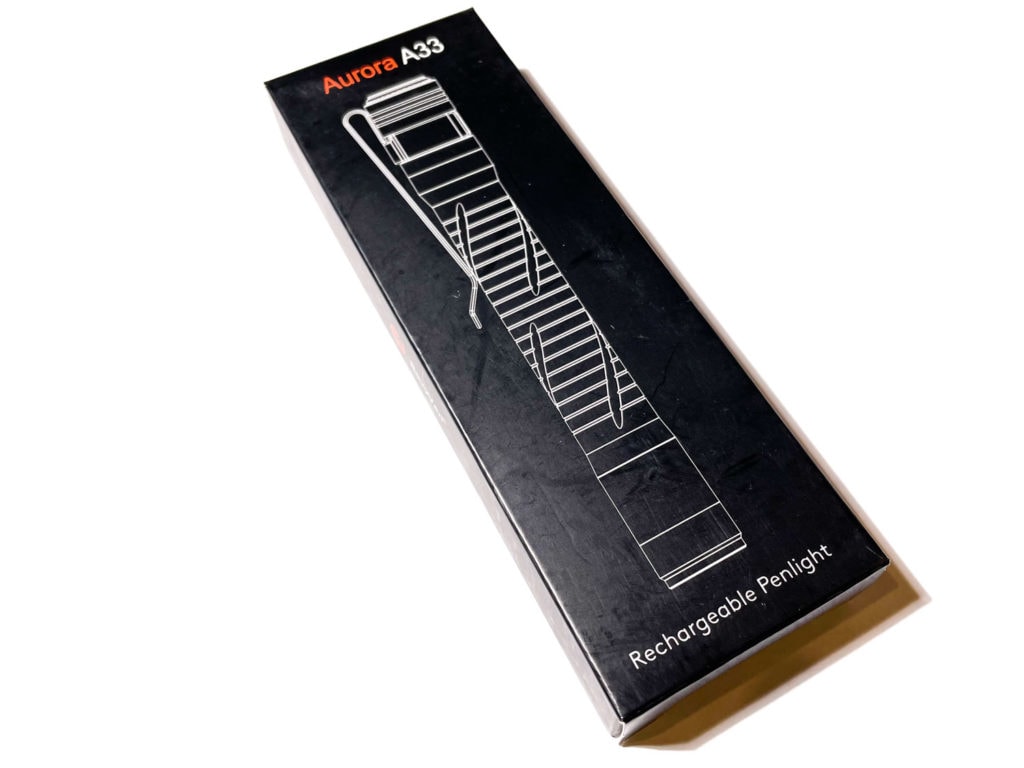
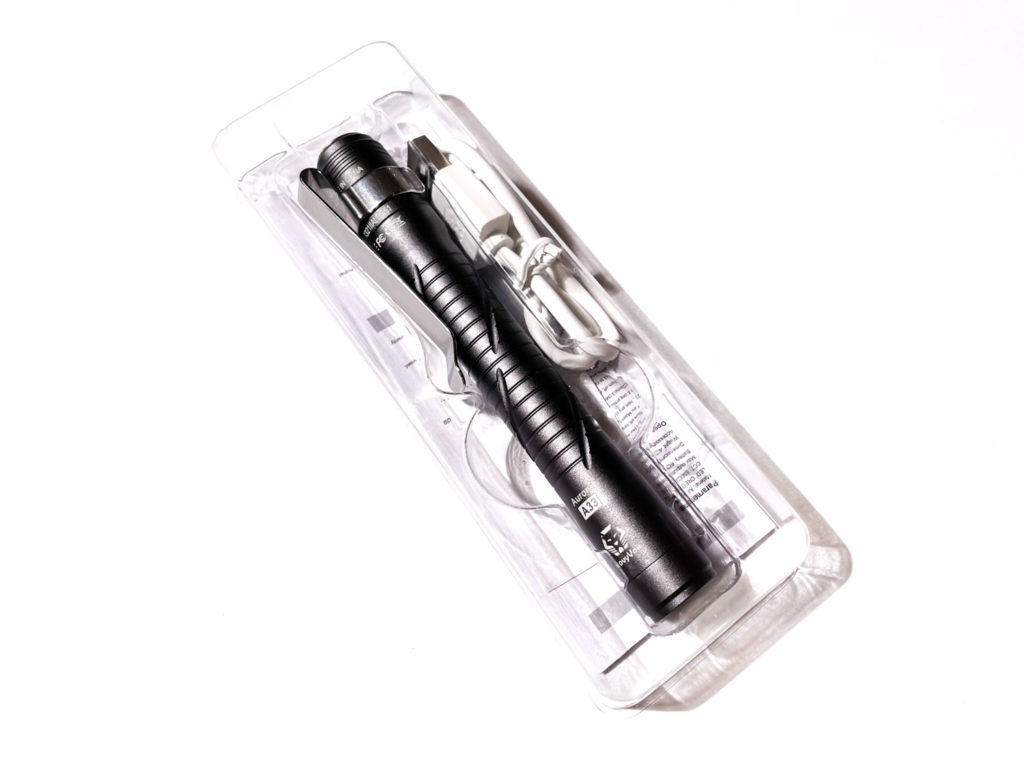
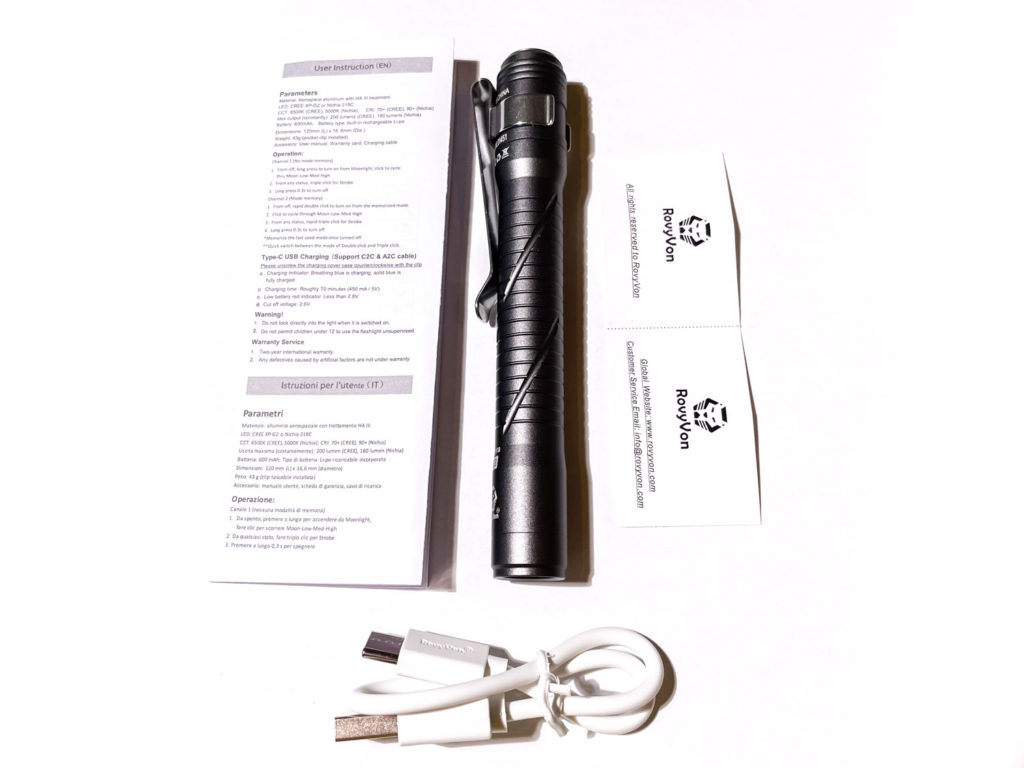
Flashlight in use
The A33 is styled like a classic penlight, fairly thin and long which fits nicely in the hand. It’s in between a AA and AAA light. It sits very comfortable in the hand even if held in a clenched fist. The single rear e-switch is easy to reach when holding the light.
The knurling on the light combines standard circular grooves running down the length of the body with helical type spiral cut outs running through them as well. This helps somewhat with grip however the finish of the light is quite smooth and is not very grippy. The switch also has some ringed cutouts which helps to keep your finger on the button, however the switch itself needs some work. If pressed off center it can get stuck under the protective bezel and binds up. The feel of the button is also rather mushy, though it is not terrible and has very short action that some users may appreciate for quick actuation. It seems adequately sized for a light of this type and all in all suits the intended use case.
The rear cap unscrews on helical threads a set distance to expose the USB C port and charging indicator LED. When doing so the button is recessed so do not expect to be able to use the light while charging. The LED shows the charge status of the internal battery and holds solid blue when fully charged. The tail cap allows for tail standing quite easily. The removable polished pocket clip allows for deep carry and prevents rolling when installed. The piece that slots into the fabric of the pocket is rather small though and requires some work to get it to sit deep in the pocket. There is no lanyard attachment however it could be fit through the pocket clip. All in all it fits very nicely in the pocket.
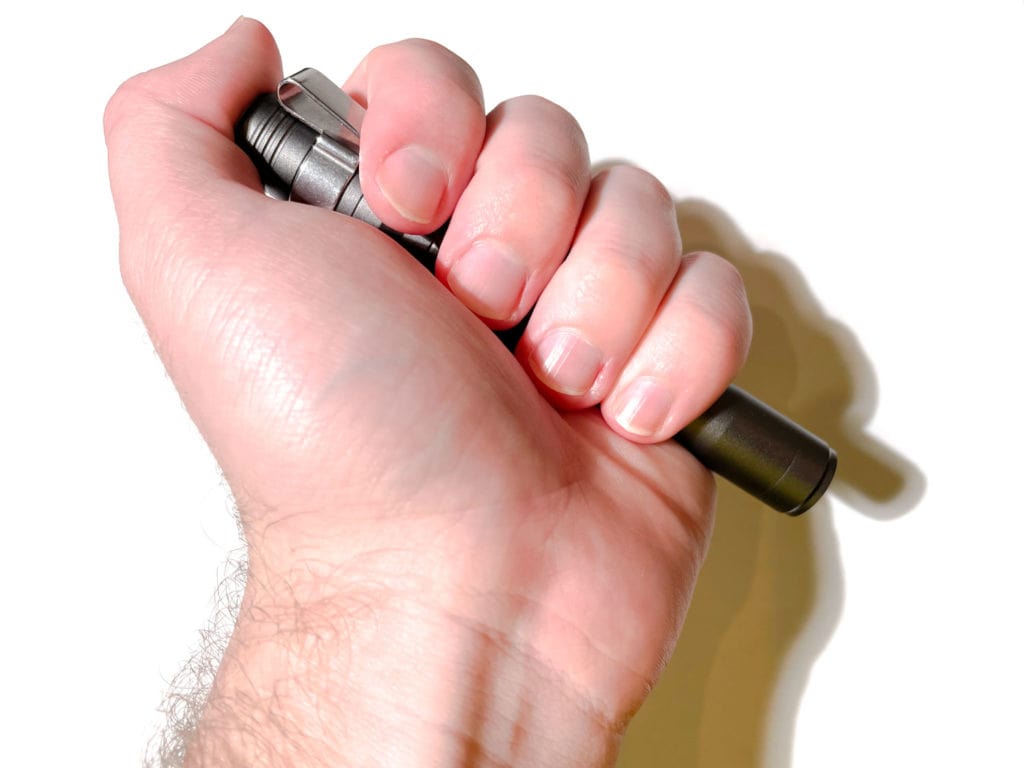
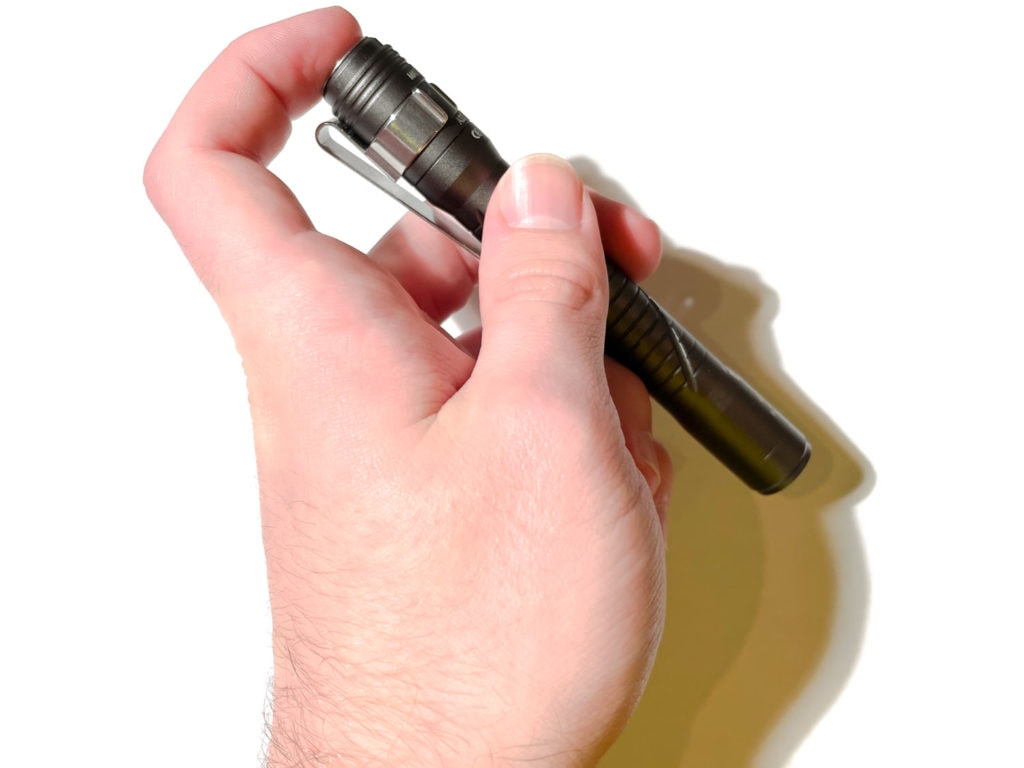
Build Quality, and Warranty
RovyVon is well known among flashlight enthusiasts and their keychain light I have owned has held up well for over a year of usage on my keychain.
The body is made of an aluminum alloy, the exact number is not given by RovyVon however a reasonable guess would be the classic 6061, a good mixture between strength, weight, and cost. The machining overall is quality with no defects and all tool marks have been polished out. The anodization is high quality and quite smooth with a uniform application. The only issue is with the threads on the “tailcap” which are somewhat gritty and do not turn easily.
All areas of the light are well sealed with the head glued on and the tailcap sealing against an o-ring seemingly justifying the IPX8 rating. That being said, there are only aluminum components on the light and you do not have a steel bezel to protect it against drops so the usual care must still be taken. It is impossible to discern anything about the interior of the light without cutting it open and this risks destroying the fully integrating lithium ion battery. However, it seems to have held up well to standard use and I cannot see any issues with how they have built it.
RovyVon is a well established brand in the flashlight world by now and has fairly good customer service. While I have had no issues, others who have had failures in the lights have been able to reach out to them via their website and they are usually quite good about getting you helped out.
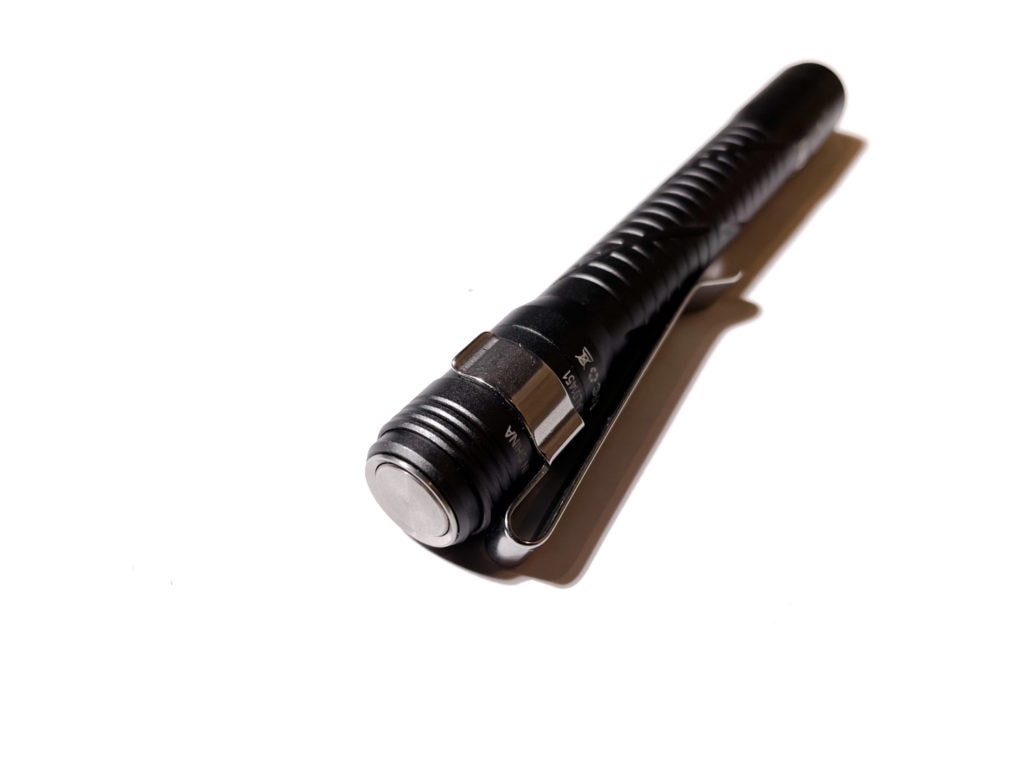
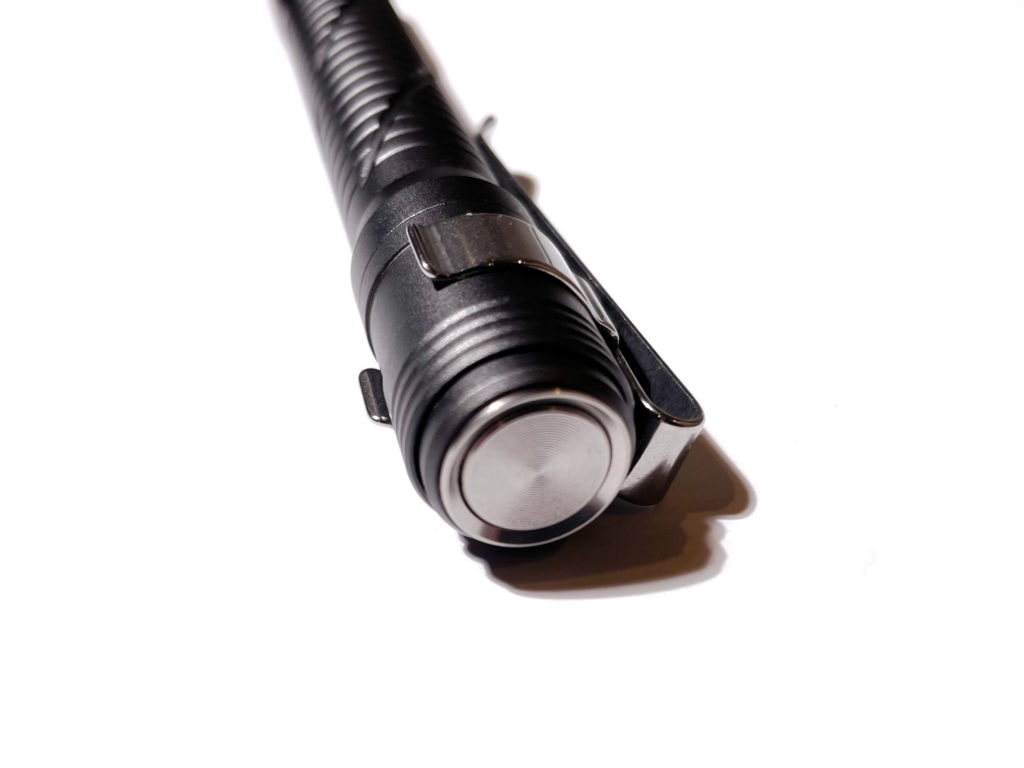
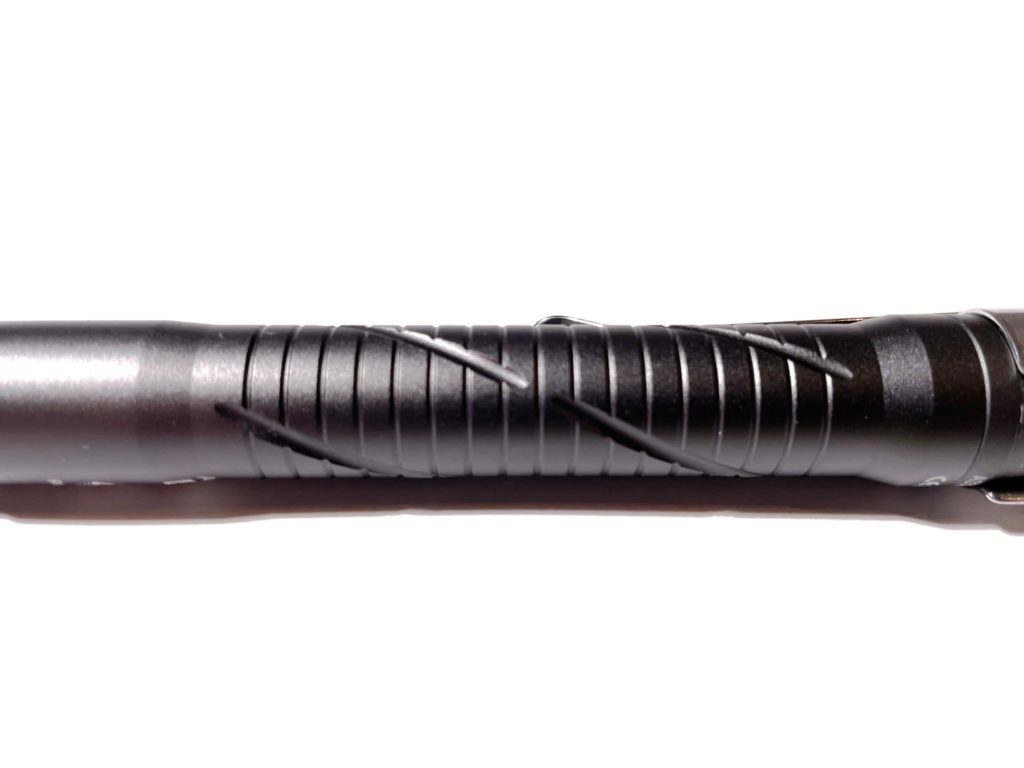
LED, Lens, Bezel, Beam, and Reflector
RovyVon offers two classic LED options, a CREE XP-G2 and a Nichia 219C. The XP-G2 offers higher output at the expense of tint and CRI, while the Nichia fills in both those gaps and sacrifices output. I have the Nichia 219C version, which comes domed to improve output. RovyVon only offers the 5000K variant of this emitter, which is overall pleasant other than being a little cool for my tastes. The XP-G2 comes in 6500K to maximize effective output. For small lights like this these 3535 footprint LEDs are very reasonable options and allow a user to prioritize what they want from their new flashlight.
The A33 used a TIR optic with a smooth reflector nestled beneath a glued in aluminum bezel. It is not a terribly large bezel and will suffice to protect the lens from small drops, however it will likely suffer a dent due to the material used. The lens appears to be hardened mineral glass with an anti reflective coating.
The beam is nice, exactly what you would expect from a 219C. It has a nice balance of spill and throw with a very usable hotspot. The tint is on the cooler side but the 5000K is still nice to look at compared to some of the 6000-6500K offerings and suits this light well.
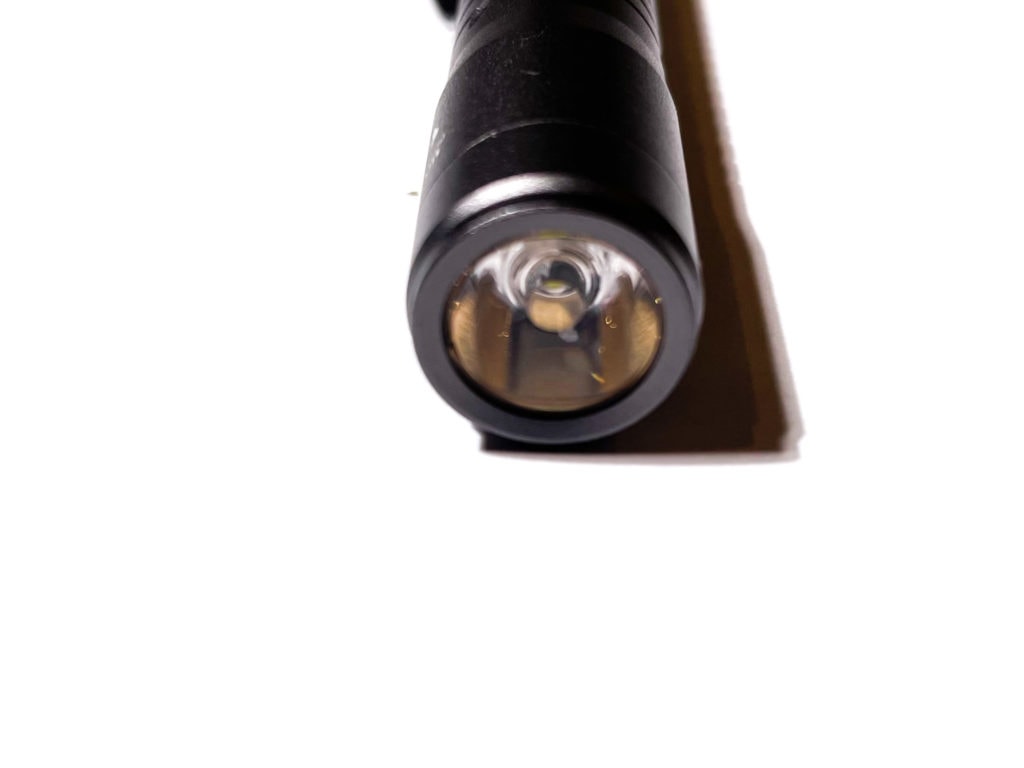
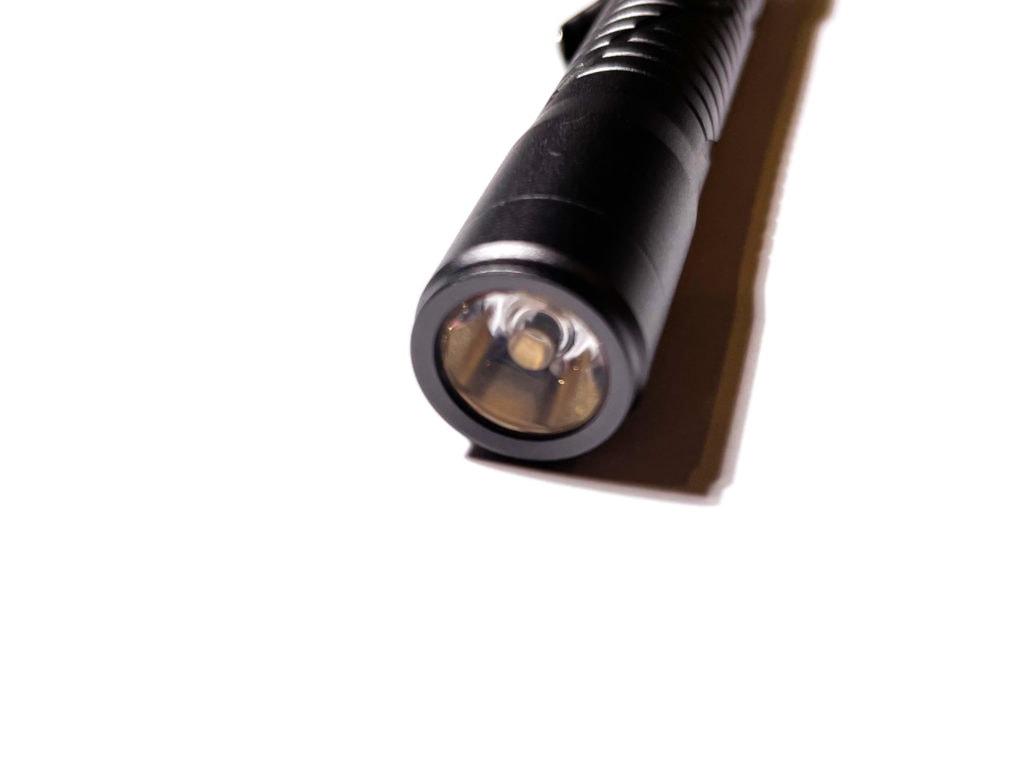
Dimensions and size comparison
Dimensions:
| Dimension | Millimeters | Inches |
| Length | 12.7 | 5 |
| Head diameter | 15.7 | 0.62 |
| Body diameter | 13.7 | 0.54 |
Weight:
| Weight | Grams | Oz. |
|---|---|---|
| Without battery: | N/A | N/A |
| With battery | 41 | 1.45 |
Here is the A33 compared to some similar lights in the EDC category, providing a small and large comparison of other popular EDC lights.
From left to right: Lumintop FWAA, RovyVon A33, Acebeam E70
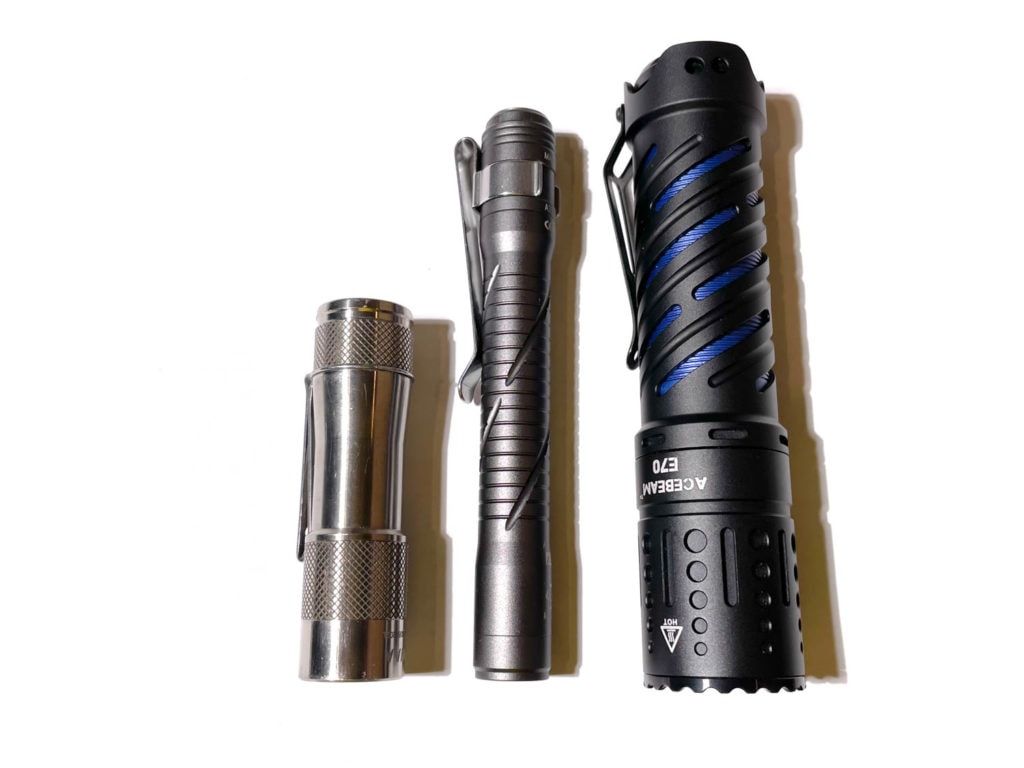
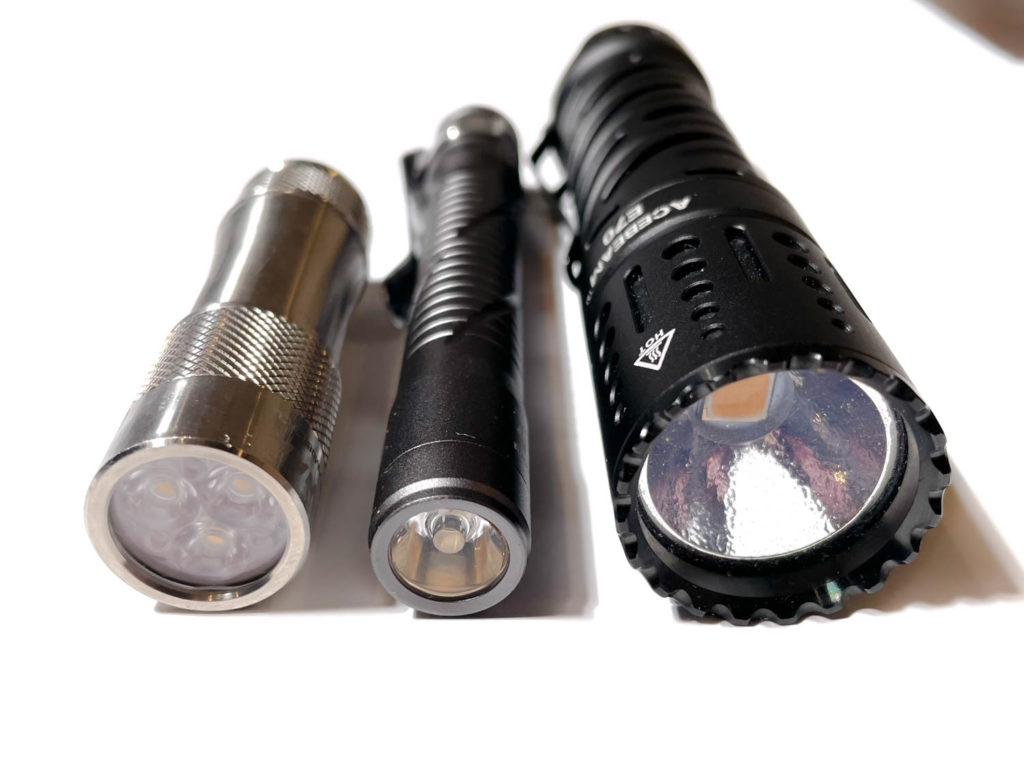
Driver & User Interface:
RovyVon lights have historically had rather quirky UIs and this is no exception, though it is not terribly complicated. The single rear e-switch controls all functions of the light allowing the user to select one of four brightness levels and activate a strobe mode.
Available Modes: Moonlight, Low, Medium, High, Strobe From OFF
- Long click to turn on moonlight
- Double click to go to memorized mode
- Triple click to turn on strobe
Mode Memory:
- Yes, UI recalls the last used mode and double click with activate it
Low voltage warning:
- Yes, the battery status LED turns red. Covered during normal use by tailcap.
Strobe Shortcut
- Triple click to activate strobe from either OFF or ON
Lock-out mode:
- No UI lockout, can retract the tailcap to shield the button however this does not fully prevent the light from turning on as the button can still be pressed
PWM
- None
Additional info on the UI: The UI isn’t terrible however I hate hate hate lights that require me to long press to turn it on. While this is not a tactical light, it still makes it difficult to use. Additionally, you can only cycle up in brightness and have to loop around to moonlight if you overshoot your desired brightness. That being said, once used to it the UI works fine though it is quite a pain as a new user.
Batteries & Charging
The A33 has a fully integrated 600 mAh lithium ion internal battery that is not user replaceable. It charges by way of the USB C in the tailcap which is exposed by twisting back the cap. Charging from a 5V USB source the manual claims roughly 70 minutes to charge to full and seems reasonably in line with my real world experience.
The elephant in the room: the internal battery is not user replaceable. On one hand it is nice to not have to worry about the battery, however should the battery go bad the entire light must be replaced. It is up to the user to decide if this is a “feature” they like and if they are willing to replace the $22.99 USD cost off the light should the battery fail.
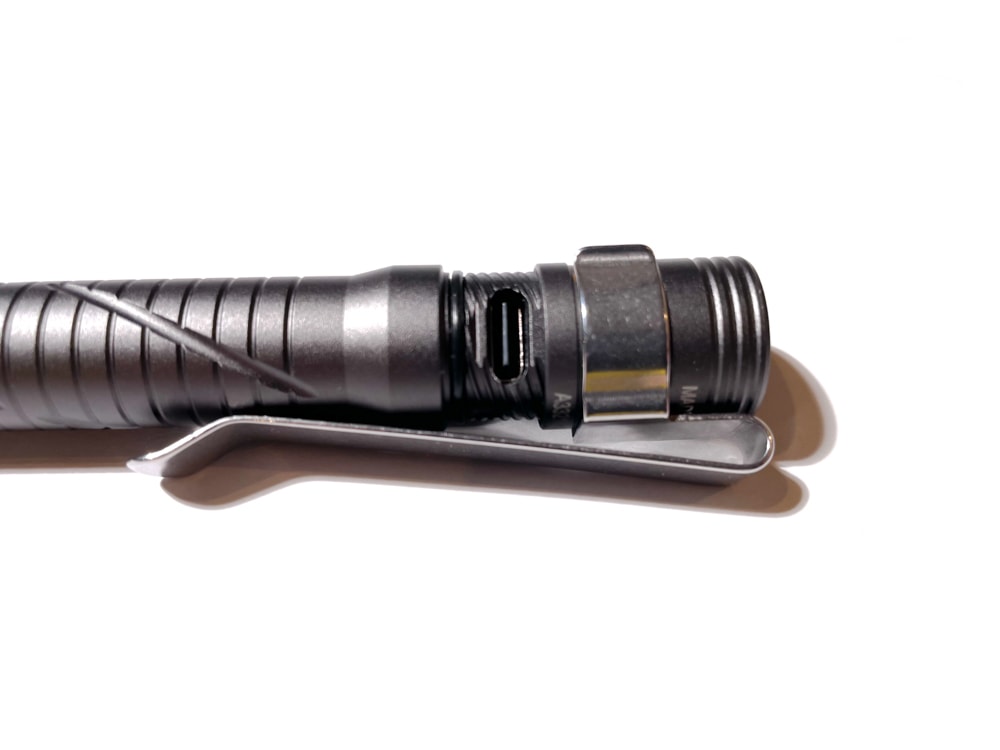
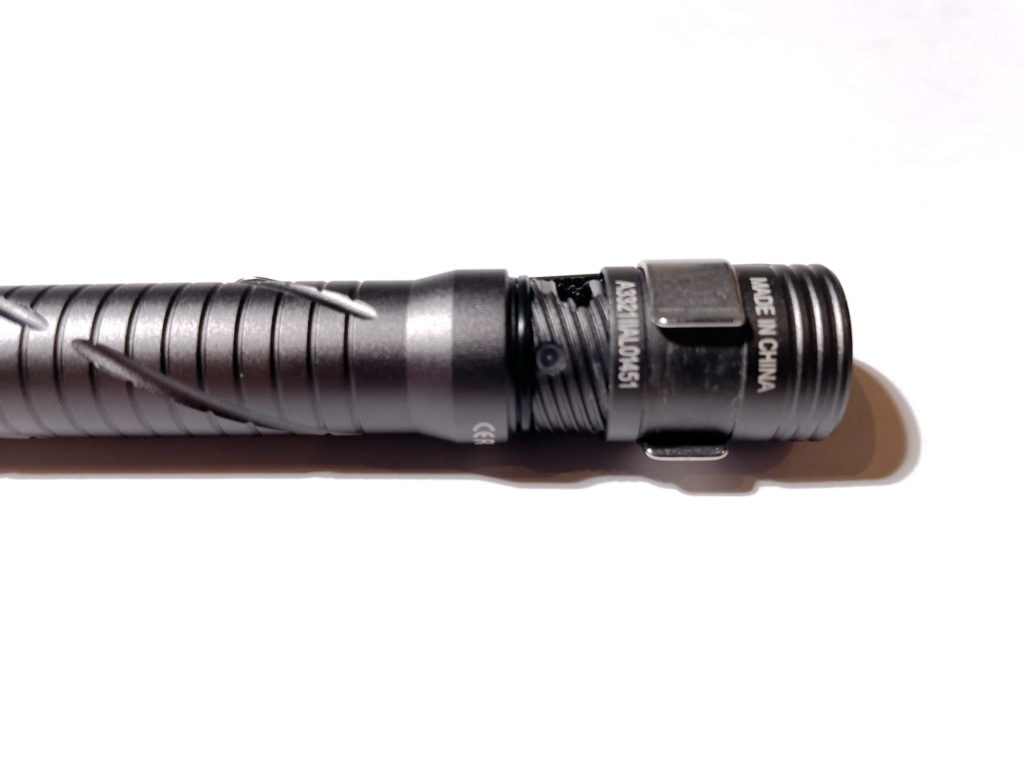
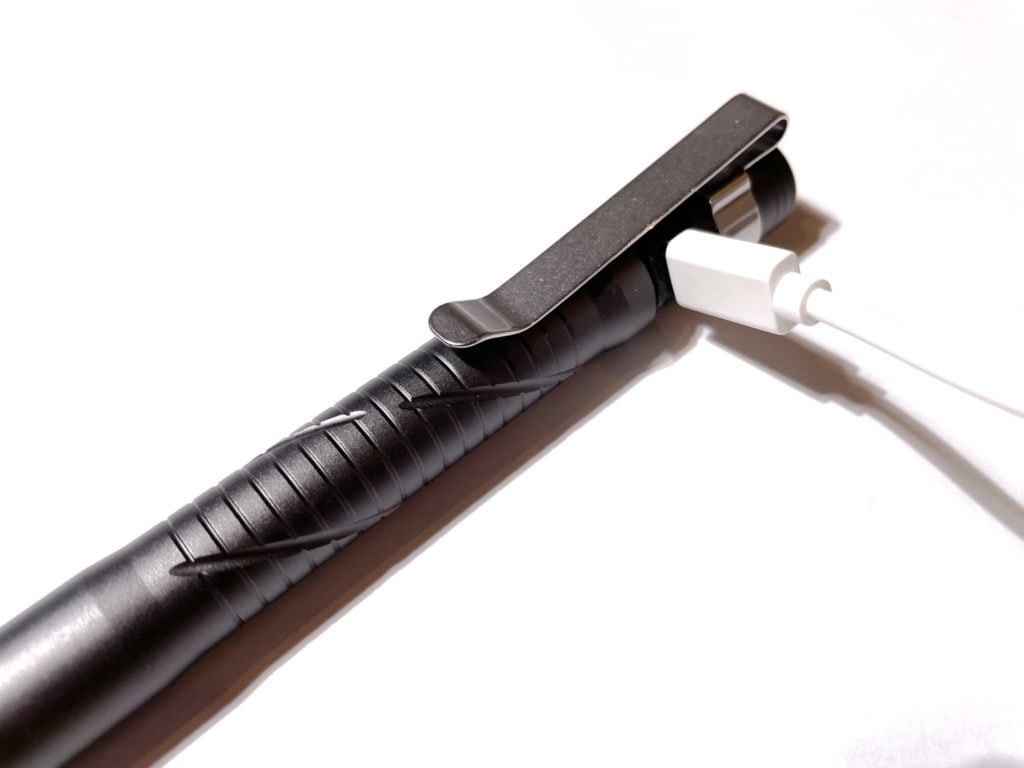
Performance test
I used a homemade integrating sphere alongside a MT-912 Luxometer by Alpthy. Unfortunately this meter is not data logging so I set up my phone to record a video of the reading to be graphed separately. The internal battery was fully charged. Amps could not be measured as the current path was not accessible due to the nature of the light.
| Mode | Specs | @turn on | 30 sec | 10 minutes |
|---|---|---|---|---|
| Moonlight | 0.5 | N/A | N/A | N/A |
| Low | 12 | 3 | 2 | 2 |
| Medium | 50 | 28 | 26 | 24 |
| High | 180 | 139 | 126 | 121 |
RovyVon did consistently overstate the output of the light however the output is still quite usable for a light of this kind. During my daily use of the light during work I found the output to be more than adequate and frequently left it on medium to avoid producing a blinding amount of light during up close inspections. That being said, if you are looking for a “pocket rocket” this is not the light for it.
Parasitic drain:
- Unable to measure
Runtime graph
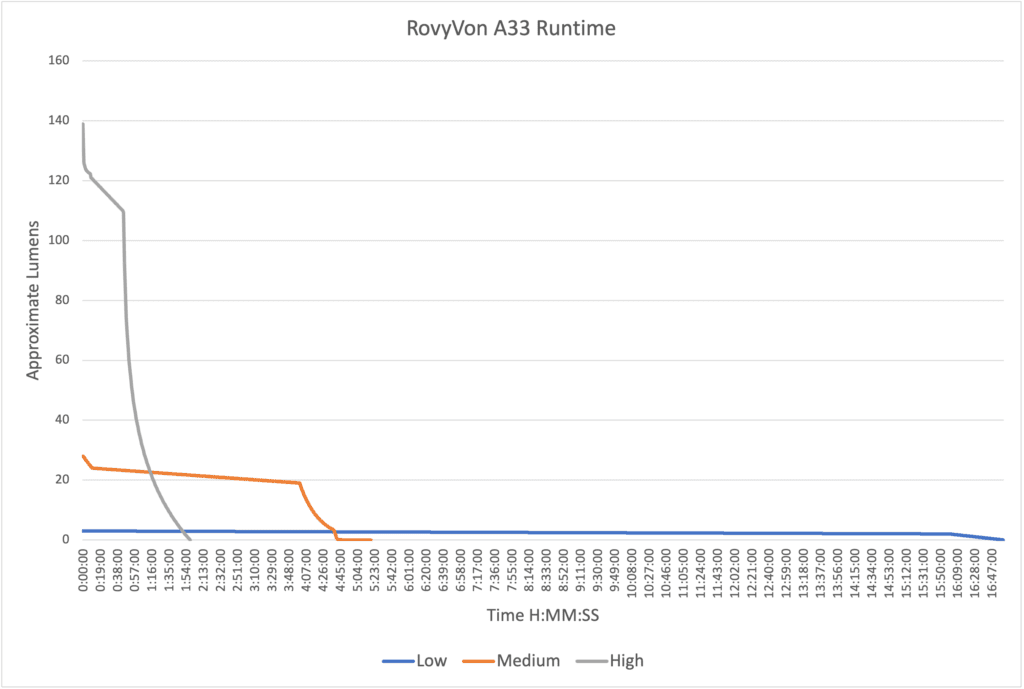
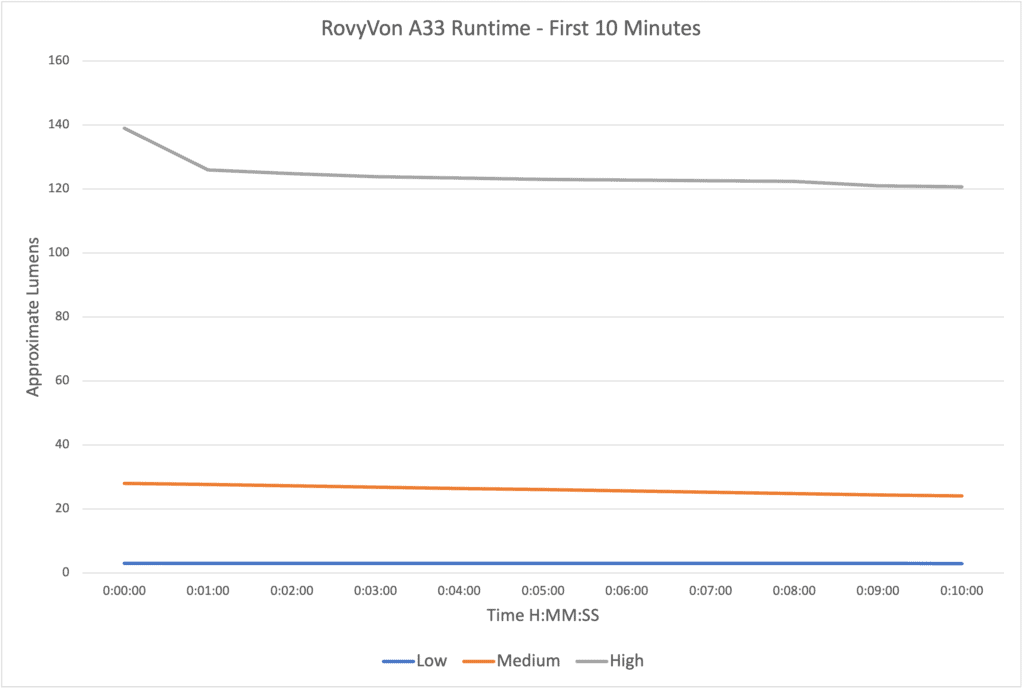
| Mode | Specified | Measured runtime |
|---|---|---|
| Moonlight | 60H | N/A |
| Low | 15H | 17H |
| Med | 5H | 5H |
| High | 1H | 2H |
RovyVon’s runtime numbers were actually understated and you get a very usable amount of time between charges. However you do only get an hour of effective “high” mode before a rapid step down. The internal 600 mAh battery seems to be of good quality, though I do wish I could measure the voltage it stops at before the light shuts off to see how far it discharges the cell. On both the medium and low modes there is virtually no step down and you get a very nice amount of runtime. All in all, no real complaints here for a light of this kind, the A33 seems to be nicely efficient for a light in this price category.
Throw numbers:
I used my MT-912 Lux Meter at three meters with the internal cell fully charged.
| Mode | Specs | Candela measured | Meters | Yards |
|---|---|---|---|---|
| Moonlight | N/A | N/A | N/A | N/A |
| Low | N/A | 54 cd | 14.7 m | 16 yd |
| Medium | N/A | 222.75 cd | 30 m | 32.8 yd |
| High | 110 cd | 900 cd | 60 m | 65.6 yd |
Throw was actually quite impressive from a light of this size, largely thanks to the TIR optic. On high you get a whopping 60 meters of throw from this little penlight, something that really impressed me. Even with a domed emitter these are very solid numbers.
Beamshots
I compared the A33 against the Reylight Pineapple AA, another penlight style light running on a 14500 Vapcell lithium ion. The wall is roughly five meters away. Both lights on high are quite close, however the Reylight’s medium mode is set much higher than the A33’s. The Rovyvon’s low mode is also lower than the Reylight’s.
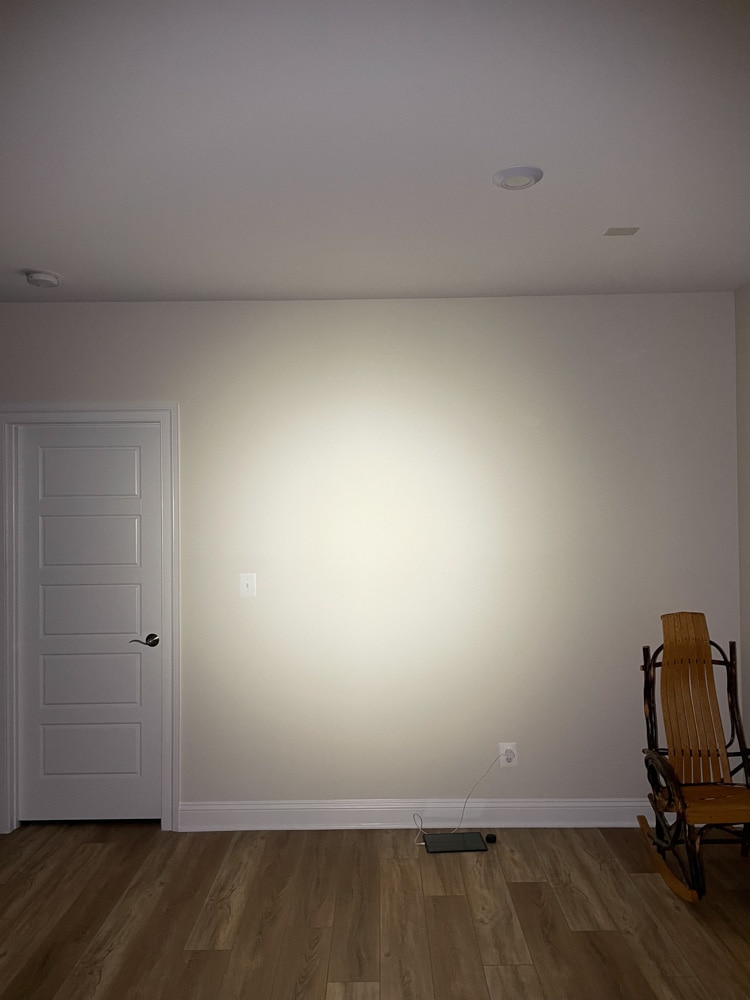
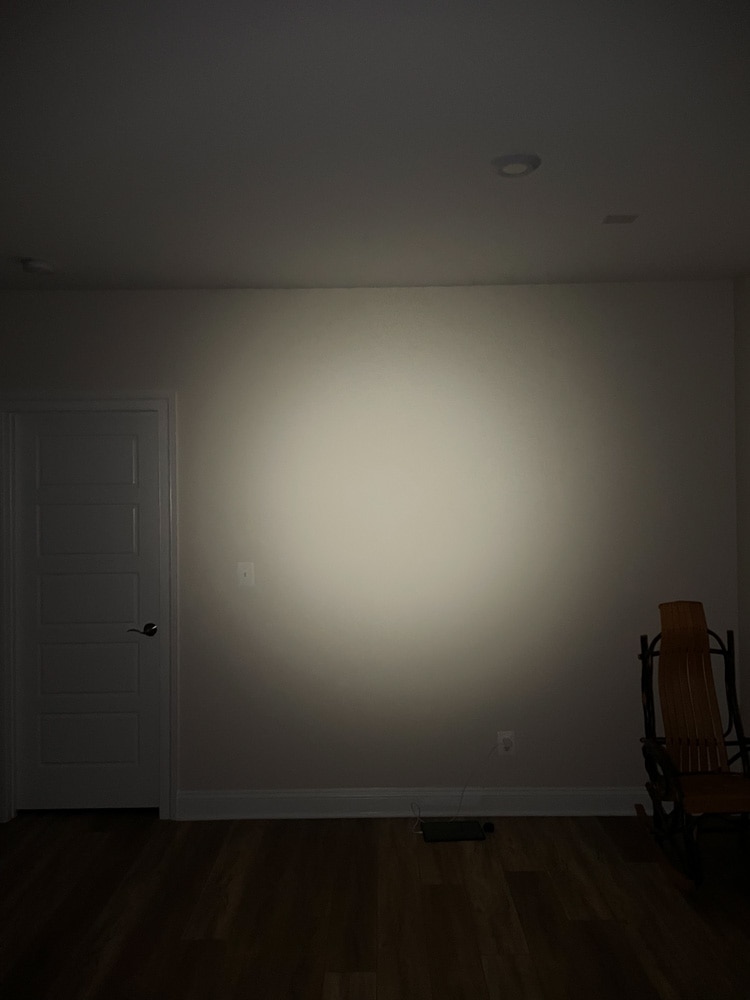
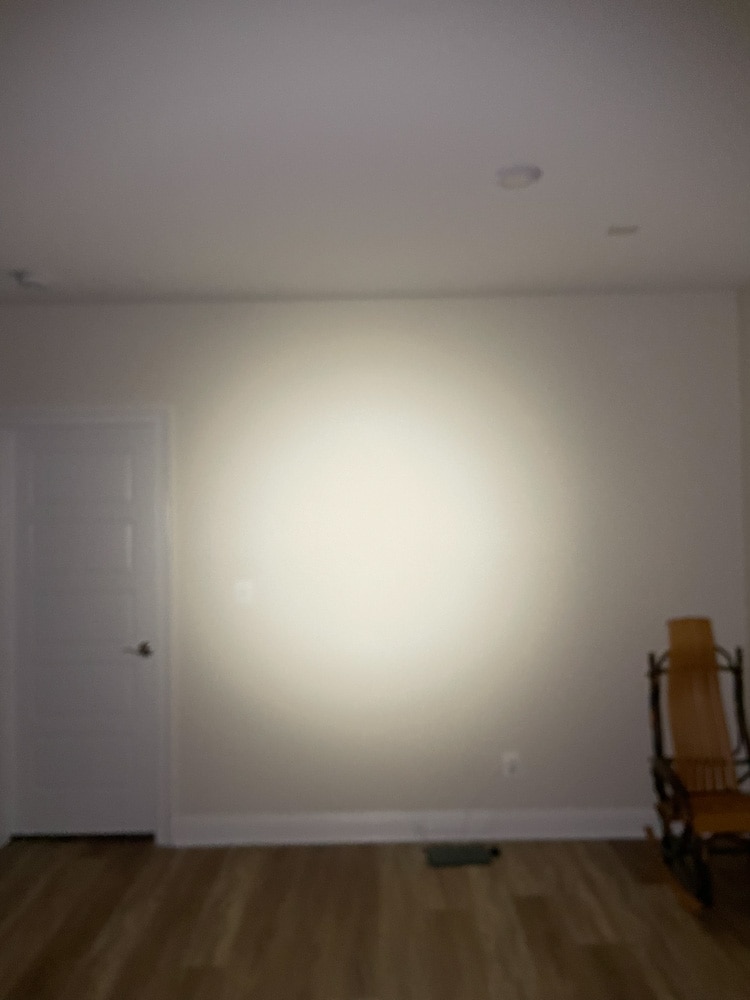

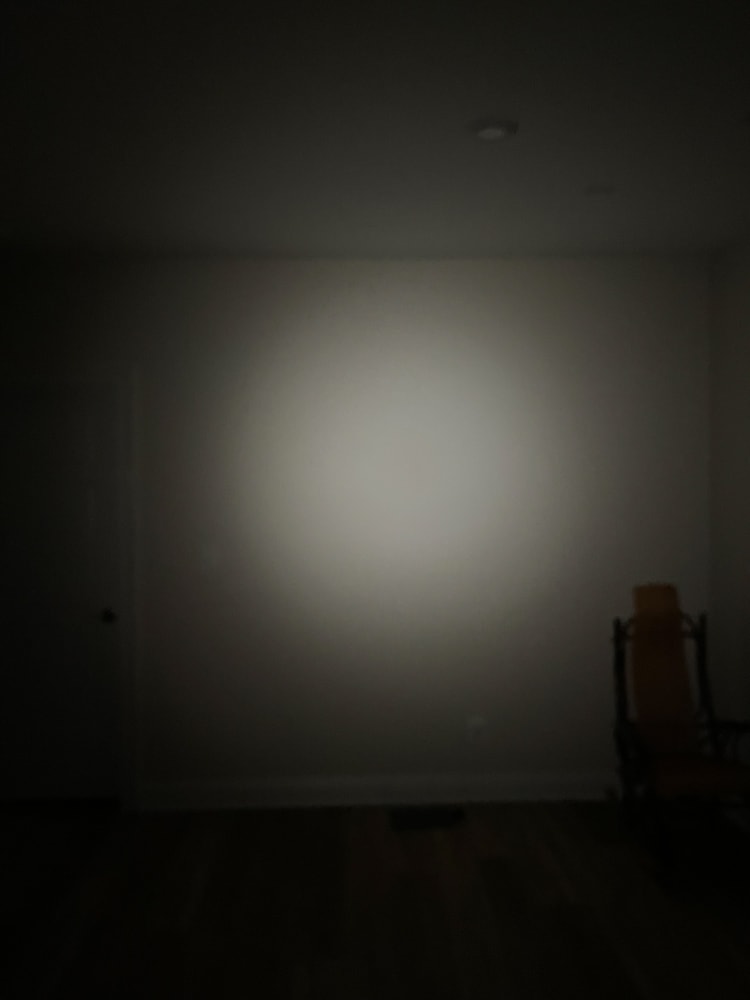
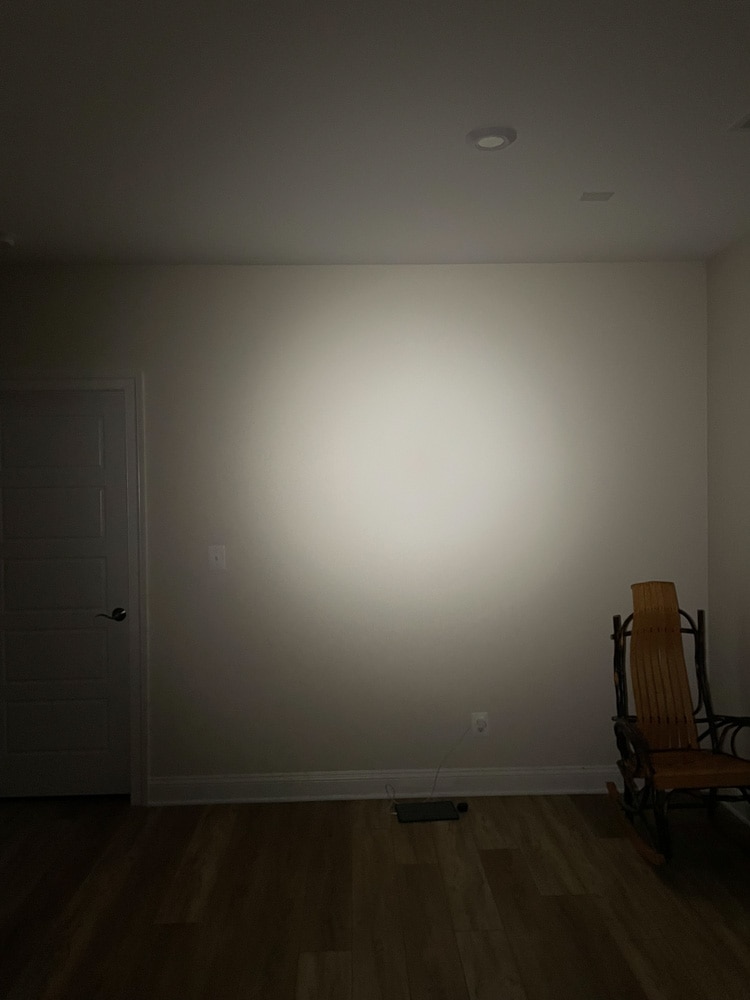
Disclaimer: I bought this flashlight with my own money. Nobody paid me to review this flashlight, nor have I been holding back on problems or defects.
Final Verdict
Pros
- Build quality is solid, anodization is nice
- Beam is nice
- Good runtimes
- Impressive throw
Cons
- No replaceable battery
- UI is a little strange to get used to
- Switch can get stuck if pressed off center
- Low voltage LED covered during use
Explanation on star ratings:
1: Avoid: my phone flashlight would be a better choice – 2: Poor: significant defect or issues; almost unusable – 3: Average: some defects or issues; but still usable 4: Good: recommended (minor issues) – 5: Great: highly recommended
Author: Max
4 stars: ★★★★
RovyVon has brought some very interesting products to market, and this is no exception. They moved more mainstream with the A33 and brought a very nice penlight to market. This light is actually a little basic compared to some of their other offerings and I think they made the right call here. The USB-C recharging is a very nice feature to have and offers a lot of convenience. The A33 boasts very good runtime and throw alongside a perfectly usable output which make it a very solid contender among other penlights such as those offered by Coast, and I would say it more than beats the competition. That being said, some things like a non replaceable battery, wonky UI, and a mediocre tail switch hold it back from a higher ranking. All in all, four stars for the A33.
RovyVon A33 for sale:
1lumen selects and reviews products personally. We may earn affiliate commissions through our links, which help support our testing.